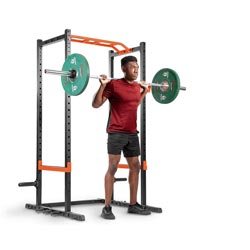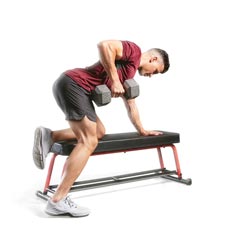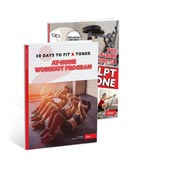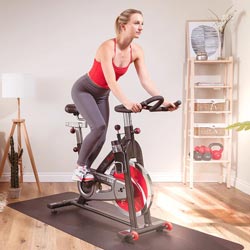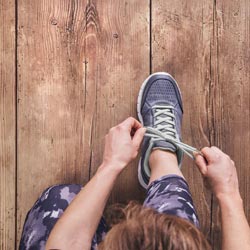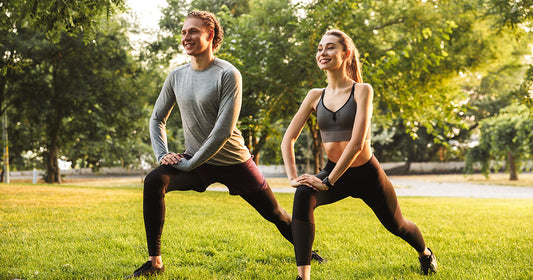For years, Low-Intensity Steady State (LISS) cardio has been used to boost cardiovascular health and enhance fat loss by increasing calorie burn.
Recently, High-Intensity Interval Training (HIIT) has been famed for being a quick and fun cardio alternative that burns more calories in less time, and keeps burning calories long after your workout is over (1).
But which workout gets better fitness results: HIIT or LISS? And which is more effective when trying to lose weight?
In this article we’re taking a deep dive on both LISS and HIIT. Then, we’ll compare the two to find out which is best for you.
What is LISS?
LISS stands for “Low-Intensity Steady State’. LISS is cardio done at a low intensity. Due to the low-intensity nature of a LISS workout, it can typically be performed for long periods of time.
LISS workouts should be easy enough to allow you to hold a conversation as you work out, without gasping for air. Throughout the duration of your workout, your intensity shouldn’t change, with a 40% Heart Rate Max (HRmax) – 70% HRmax, peak intensity(2).
Examples of LISS include walking on the treadmill, exercising on an elliptical, Stairmaster or bike at a low intensity, and many others(1).
What is HIIT?
HIIT stands for “High-Intensity Interval Training’ and is a type of cardio that contains short bursts of intense work with periods of low-intensity or even rest in between.
Typically, a 3:1 or 4:1 rest-to-work ratio is used. For example, in a 3:1 approach on a bike, you would pedal at a low intensity for 45 seconds and then burst into an all-out-sprint for 15 seconds and repeat until you’ve completed at least 8-10 intervals.
During periods of work, aim to hit a peak intensity anywhere from 80% HRmax – 100% HRmax(2). Allow yourself to fully recover in between each interval so you can give each push your best.
Examples of HIIT include: indoor bike sprints, treadmill sprints, sled pushes, battle rope pulls, and many others(1).
Is HIIT or LISS More Time Efficient?
Countless studies have shown that the most cited reason for not exercising is a ‘lack of time’. Regardless of age, ethnicity, sex, or health status, people report that a lack of time is the primary reason for their failure to exercise on a regular basis(3).
Given that lack of time is such a common barrier to exercise participation, HIIT workouts (infamously shorter and more efficient than LISS workouts) may present a compelling solution if you find the high intensity nature of HIIT workouts suitable for you, learn more below!
HIIT Workout Duration
HIIT workouts can range anywhere from 10-30 minutes. Some HIIT workouts may range above 30 minutes for endurance athletes specifically training for performance. For those simply looking to boost fitness results and burn calories, HIIT workouts 30 minutes and below should be plenty sufficient.
LISS Workout Duration
LISS on the other hand can range from 30 to 60 minutes. Keep in mind, because LISS is “steady state” in nature, your effort level or intensity should be consistent throughout the entirety of the workout. To maintain your pace, you’ll need to lower your effort level and focus on consistency.
As you lower your effort level, you burn less calories within the same time period; meaning, you’ll need to work out for longer periods of time during a LISS session just to burn as many calories as you would during a HIIT session.
Does HIIT or LISS Yield Better Fitness Results?
Research indicates that HIIT offers several advantages over steady state aerobic training(4).A few of the highlights are listed below.
HIIT is Associated with Improved Cardiovascular Fitness
Recent studies have revealed that improvements to cardiovascular fitness depend on the intensity of your workout. This means, improvements to cardiovascular fitness via HIIT training may be superior to traditional steady state cardiovascular training(4).
HIIT is Associated with Improved Fitness Performance
The latest research has shown that HIIT offers greater improvements in VO2max, endothelial function, blood pressure, cardiac contractility, insulin signaling, and contraction coupling when compared with moderate-intensity aerobic exercise(4).
HIIT is Better for Weight Loss
Studies exhibit HIIT as a superior training format for those attempting to lose weight. While moderate-intensity steady-state aerobic exercise (the so-called ‘‘fat-burning zone’’) results in an increased percentage of fat burned for calories during a workout; total caloric expenditure and lipolysis (i.e., fat breakdown) are substantially greater during a HIIT session(4).
HIIT Burns More Calories Even After Your Workout is Over
Finally, HIIT heightens excess post-exercise oxygen consumption, also known as the ‘‘afterburn effect’’. Which means, you burn more calories not only during HIIT workouts but long after your HIIT workout is over(4) .
Is HIIT or LISS Better for You?
There are two variables that you should take into consideration, when trying to decide on which type of workout (LISS or HIIT) would be best suited to you. The first being, how much time you are willing to dedicate towards your workout regimen. The second, how much effort you’re willing to put into your workouts.
Choose HIIT if…
If you’re someone that is on a limited time constraint and wishes that there were more than 24 hours in a day, then HIIT would probably be the most logical way to go. Just remember that you must be willing to get ‘comfortable with the uncomfortable’ and put in the effort, to see the results that you’re looking for. It’s also important that a solid base of cardiovascular fitness be established prior to integrating HIIT into your program.
Choose LISS if…
If you’re someone that finds themselves having an ample amount of time & doesn’t like to feel uncomfortable, then LISS is probably the more suitable route for you.
Choose both if…
If you find yourself somewhere in the middle, try filling your calendar with a blend of HIIT (maybe 1 or 2 sessions a week) and LISS the other days of the week. A blended routine can help with keeping you engaged throughout your weekly workout regimen and will also allow your body to make a full recovery, so that your mind & body feel rejuvenated and you’re ready to put forth the effort needed for your next workout.
In Closing
HIIT and LISS are both great forms of cardiovascular exercise. Choose whichever style is best suited to your schedule, taking the above considerations into account and you will see fitness results. If you’re ready to get started, be sure to visit our workout page on the Sunny Training Hub for a full library of cardio workouts at your fingertips!
(1) HIIT vs LISS Cardio- Which is Superior, Journal, 2022. https://physiquedevelopment.com/hiit-vs-liss-cardio/ Accessed 4 April, 2022
(2) Metabolic Adaptations to Short-term High-Intensity Interval Training
A Little Pain for a Lot of Gain, Journal, 2008. https://journals.lww.com/acsm-essr/Fulltext/2008/04000/Metabolic_Adaptations_to_Short_term_High_Intensity.3.aspx%C2%A0 Accessed 4 April, 2022
(3) HIIT vs Continuous Endurance Training: Battle of the Aerobic Titans, Journal, 2006. https://www.unm.edu/~lkravitz/Article%20folder/HIITvsCardio.html Accessed 4 April, 2022
(4) High-Intensity Interval Training: Applications for General Fitness Training, Journal, 2009.

